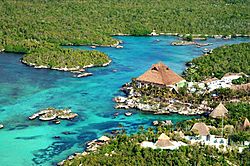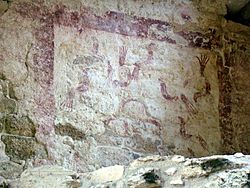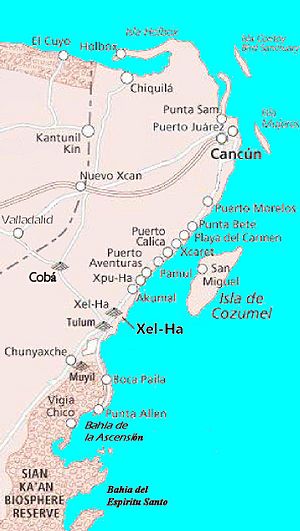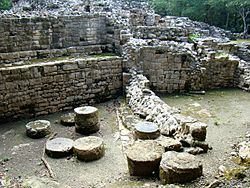Xelha facts for kids
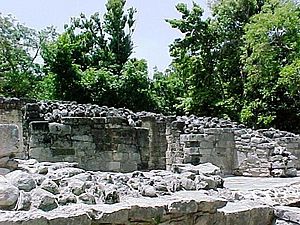
Ruins at Xel-Há
|
|
| Location | Quintana Roo, Mexico |
|---|---|
| Region | Yucatán Peninsula |
| Coordinates | 20°19′11″N 87°22′01″W / 20.31972°N 87.36694°W |
| Type | settlement |
| History | |
| Material | limestone, stucco |
| Founded | pre 1st century |
| Abandoned | 19th century |
| Cultures | Mayan |
Xel-Há (pronounced "shel-HA") is an ancient city built by the Maya civilization. It is an archaeological site located on the eastern coast of the Yucatán Peninsula in Mexico. Today, this area is part of the state of Quintana Roo.
The name Xel-Há comes from the Yucatec Maya language. It combines two words: xel, which means "spring," and ha, which means "water." So, Xel-Há means "spring water" or "where the water is born." This name makes sense because of the beautiful natural lagoons and inlets found there.
Today, the lagoon and inlet at Xel-Há are part of a popular water theme park. It is known as Xel-Ha Park.
Contents
History of Xel-Há
The ancient city of Xel-Há is located south of the modern town of Playa del Carmen. This area is in the state of Quintana Roo, Mexico.
We are not completely sure when Xel-Há was first built. However, people were living there by the 1st century AD. The city was very active during the Classic and Postclassic periods of Maya history. Many of its buildings were rebuilt during the Late Postclassic period. It seems the city was not fully abandoned until the 19th century.
An ancient stone monument, called a stela, was found at Xel-Há. It has a date from the Early Classic period, which is AD 564. This stela was discovered in 1841 by explorers John Lloyd Stephens and Frederick Catherwood.
Xel-Há as a Maya Port
Xel-Há was an important port city for the powerful Maya city of Coba. Other key ports for Coba included Tancah and Tulum. Xel-Há was likely a busy place where the Maya traded with other groups. These groups traveled by sea between the 7th and 12th centuries. Later, European sailors were also drawn to this important coastal spot.
Spanish Arrival and Settlement Attempts
In the early 1500s, Xel-Há became a base for Spanish forces. This happened during the first expedition led by the conquistador Francisco de Montejo. He was trying to take control of the Yucatán Peninsula for Spain.
In 1526, Montejo received permission from the Spanish Crown to explore and settle the area. In 1527, he sailed from the island of Cozumel. He landed at Xel-Há's lagoons, near a local Maya village. Montejo decided to build the first Spanish settlement on the peninsula here. He named it "Salamanca de Xelha," after his hometown in Spain.
However, the Spanish settlers soon faced many problems. They did not have enough supplies. Many men became sick or died within the first two months. Montejo tried to get food from nearby Maya villages, but it was not enough. To stop his men from leaving, Montejo even ordered his ships to be sunk. This meant they had to stay.
Challenges and Abandonment
Eventually, Montejo's forces became more stable. He sent out groups to explore. One group of about 125 men went north. They returned months later, having lost half their men in battles with the Maya. They also lost men to disease. The 65 soldiers left behind at Salamanca de Xelha also faced many difficulties. Many were lost in Maya raids. Montejo was left with only about a third of his original group.
Luckily, another Spanish ship arrived with supplies and more soldiers. This helped prevent a complete disaster. Montejo then sent an expedition south. But this also failed to establish a foothold. Within 18 months of Montejo's first landing, the Spanish abandoned Salamanca de Xelha. They left the entire eastern coast of the Yucatán.
See also
 In Spanish: Xel Há (sitio arqueológico) para niños
In Spanish: Xel Há (sitio arqueológico) para niños


